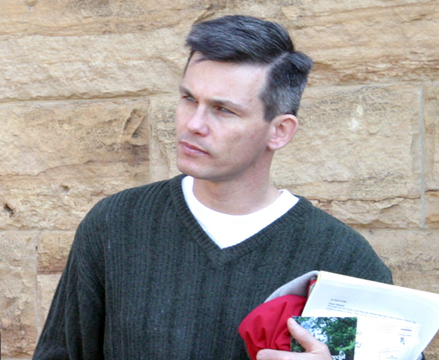 Associate Professor of Modern Languages Greg Redding’s work with two Wabash students provides a promising model for collaborative research in modern languages, the humanities, and the arts.
Associate Professor of Modern Languages Greg Redding’s work with two Wabash students provides a promising model for collaborative research in modern languages, the humanities, and the arts.
This type of research, where professor and student work together on a problem with an unknown solution, is a mainstay of science education. Often the catalyst that launches a Wabash scientist’s careers, it is less common in the humanities and the arts.
But Redding’s work with Tim Rickard ’08 and Andy Deig’08—whose interest in their research subjects was piqued during an immersion trip to German-American sites in Indiana—suggests that collaborative research can be as productive in the humanities as in the sciences.
Deig’s work with Redding focuses on the Germania Mannerchor, a club in Evansville founded in the late 1800s around the German men’s choir tradition. Conventional wisdom says these choir clubs and the more prevalent church choirs—which fueled America’s interest in men’s choir music—existed separately, with little intermixing. Deig and Redding hypothesize a more symbiotic relationship between the two, and are searching for documentary evidence to that end.
While Deig’s research delves into music, history, and language, Rickard and Redding’s examination of the correspondence between Otto Stark and his father, Gustav, studies the relationship between a first-generation German immigrant and one of the leading artists of the Hoosier School of impressionist painting.
Besides forcing Redding to spend weeks in Pennsylvania learning the archaic Kurrent form of German script, the research held other surprises.
"The stereotype for German father-son relationships during this time pits a conservative, dominant father against the artistic impulses of his son," Redding said. "But our study revealed the exact opposite of what I expected. While Gustav was clearly out of his element when discussing the art world, his letters reveal he was very supportive of Otto and his artistic career."
That support moved beyond words after Otto’s wife, Marie, died, and Gustav offered to take in Otto’s four children so that his son could pursue his career. Through letters, Gustav, whose own wife had died three years earlier, kept Otto apprised of his children’s well-being, another correspondence that flies in the face of German stereotype.
"Perhaps this relationship between father and son borrowed from both cultures, German and American—a statement of the "American Dream" merging with the Stark’s German heritage," Redding said. He and Rickard are continuing their research, looking for other examples of such father-son relationships—working with Wabash archivist Beth Swift to study the correspondence between another German-American painter, Wabash artist Fritz Schlemmer and his father, Otto.
Funded by the College’s Know Indiana grant from Lilly Endowment, Inc, Redding’s research with Deig and Rickard provides an additional variation on the model for collaborative research—work focused on often overlooked cultural and natural resources in Indiana.